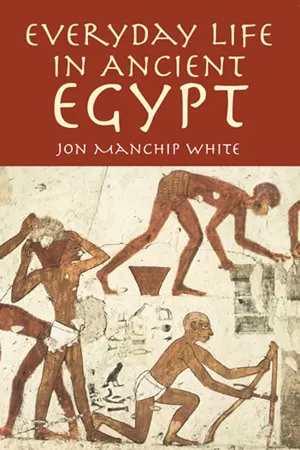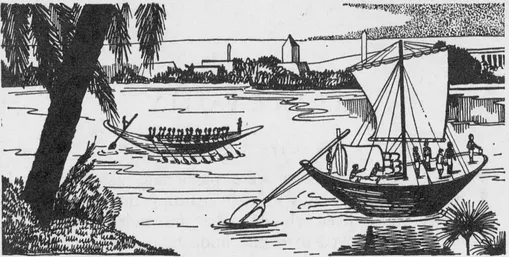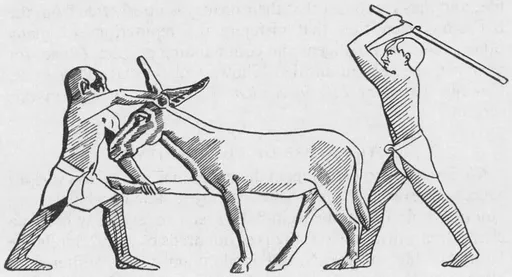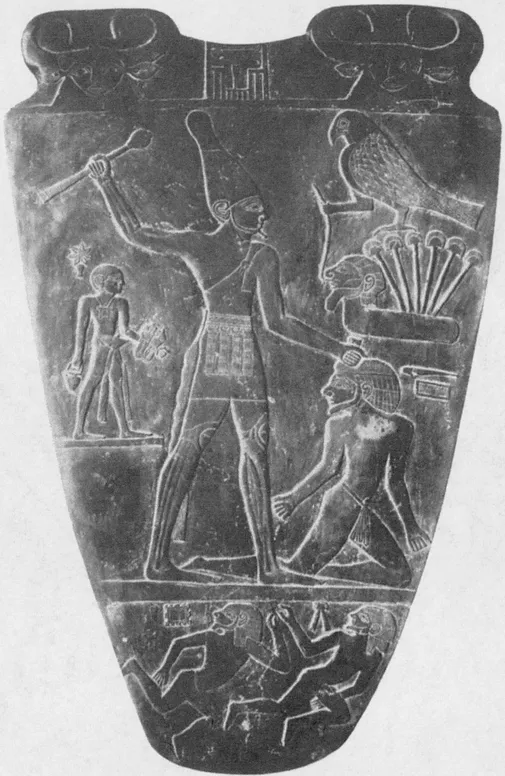
- 208 pages
- English
- ePUB (mobile friendly)
- Available on iOS & Android
eBook - ePub
Everyday Life in Ancient Egypt
About this book
Drawing on a wealth of archeological evidence, author Jon Manchip White presents a remarkably accurate picture of Egyptian life throughout dynastic times — from the end of the third millennium to the Greek occupation in 330 BC. Because social conditions changed little during these 3,000 years, readers get a clear idea of the roles and tasks assigned to each section of the community — to the Pharaoh and his noblemen; priests and soldiers; scribes and artists; and peasants, who formed the bulk of the population. How these people spent their leisure hours, how they dressed, what they ate and drank, forms of transportation used, how homes were built and furnished, and the activities of women and children are also thoroughly examined. Special emphasis is placed on the importance of religion in daily life, including the social significance of temples, pyramids, and tombs. Accompanying a vivid text are more than 100 photographs and line drawings. "A handy reference tool." — Horn Book.
Frequently asked questions
Yes, you can cancel anytime from the Subscription tab in your account settings on the Perlego website. Your subscription will stay active until the end of your current billing period. Learn how to cancel your subscription.
At the moment all of our mobile-responsive ePub books are available to download via the app. Most of our PDFs are also available to download and we're working on making the final remaining ones downloadable now. Learn more here.
Perlego offers two plans: Essential and Complete
- Essential is ideal for learners and professionals who enjoy exploring a wide range of subjects. Access the Essential Library with 800,000+ trusted titles and best-sellers across business, personal growth, and the humanities. Includes unlimited reading time and Standard Read Aloud voice.
- Complete: Perfect for advanced learners and researchers needing full, unrestricted access. Unlock 1.4M+ books across hundreds of subjects, including academic and specialized titles. The Complete Plan also includes advanced features like Premium Read Aloud and Research Assistant.
We are an online textbook subscription service, where you can get access to an entire online library for less than the price of a single book per month. With over 1 million books across 1000+ topics, we’ve got you covered! Learn more here.
Look out for the read-aloud symbol on your next book to see if you can listen to it. The read-aloud tool reads text aloud for you, highlighting the text as it is being read. You can pause it, speed it up and slow it down. Learn more here.
Yes! You can use the Perlego app on both iOS or Android devices to read anytime, anywhere — even offline. Perfect for commutes or when you’re on the go.
Please note we cannot support devices running on iOS 13 and Android 7 or earlier. Learn more about using the app.
Please note we cannot support devices running on iOS 13 and Android 7 or earlier. Learn more about using the app.
Yes, you can access Everyday Life in Ancient Egypt by Jon Manchip White in PDF and/or ePUB format, as well as other popular books in History & Egyptian Ancient History. We have over one million books available in our catalogue for you to explore.
Information
Chapter I
THE NILE VALLEY
THE CHARACTER OF THE VALLEY
THE ancient Egyptians were passionate gardeners and accomplished botanists; so it is fitting that the land in which they lived should have resembled the flower which they most loved to depict upon their monuments: the lotus.
If you look at the map of Egypt (opposite), you will see that it is like the spreading head of a flower set on a long thin stalk. The head is the fan-shaped Delta of the river Nile; the stalk is the swaying curve of the river as it unwinds its course from the First Cataract at Aswan to the distant Mediterranean. And the sap which gives life and vigour to the plant is the water of the Blue and White Niles, springing from their distant source in the heart of Africa, 4,000 miles from the sea.
With the exception of Chile, Egypt has the strangest contour of any country in the world. Most countries are round or square or elongated: but Egypt is a thread of wet green silk stretched loosely on an eternity of yellow desert.
The character and destiny of a country is controlled by its location, its conformation and its climate. Few countries have been so influenced by these factors as ancient Egypt. Egypt was the river Nile. It was a narrow carpet of soil enclosed within a rocky slot in the sands. The inhabitants of the valley huddled together on their magic carpet, which had been spread out for them by the benevolent gods at the beginning of the world; and they took good care not to stray from it. Who would be so stupid as to leave a happy valley, watched over by the gods, to wander among the demon-haunted wastes of Sinai or the Sahara?
Indeed, they had little cause to look beyond their own teeming strip of soil. If the mountains on each side of them were a barrier, they were also a protection. The land of Egypt was a blissful abode, ‘a unique and enormous oasis, a garden in a wilderness’. The sun shone down with a soft warmth and steady radiance. The mighty river spilled its waters over the fields and plantations for over 100 days in every year, laving the earth with a nourishing tilth from the uplands of Abyssinia. The soil of Egypt was so fertile in texture and so dark in colour that the ancient Egyptians called their country Kemet, the Black Land, to distinguish it from the Red Land, the arid desert in which it was situated.

2 Egypt’s great highway: the river Nile
No wonder that they praised their river, worshipped it, sang to it such sweet hymns as The Adoration of the Nile. ‘Praise to thee, O Nile, that issueth from the earth, and cometh to nourish Egypt. Thou art verdant, O Nile, thou art verdant. He that maketh man to live on his cattle, and his cattle on the meadow! Thou art verdant, thou art verdant; O Nile, thou art verdant.’
The ancient Egyptians were river-dwellers. They were born, lived and died on the banks of the maternal expanse of water which filled any traveller who came to gaze upon it with feelings of awe and wonder(2). Nor did it merely provide them with their daily sustenance: it yoked them together into a single powerful nation. It was the highway which united the stony uplands at the southern end of the lotus with the lush lands of the Delta, where the river suddenly braked and broke into a thousand filaments before it oozed its way through the marshlands to the sea. The uplands (at the lower end of the map) were originally known as the kingdom of Upper Egypt; while the Delta, whose boundary began ten miles upstream of ancient Memphis, was called the kingdom of Lower Egypt. The two kingdoms originally existed as two loose but distinct confederations of tribes for more than a thousand years; but it was inevitable that with the steady growth of population they should sooner or later coalesce, an event that occurred a little later than 3000 B.C., shortly before the beginning of the First Dynasty. Yet each kingdom still retained its own individuality. The men of Upper Egypt, where the terrain was rugged and severe, tended to be fierce and somewhat puritanical. The men of Lower Egypt, on the other hand, were mild and easy-going; they dwelt in rich and placid surroundings, within reach of the cultured lands of the East Mediterranean.
THE CHARACTER OF THE PEOPLE
Until a late stage in Egyptian history, even the lowlanders of the Delta had only limited contact with the outside world. True, there had always been an import trade in oil, wood and jewellery from such civilised countries as Syria, Crete and Phoenicia; but the trade with the savage lands of Nubia and the Sudan was equally extensive. In any case, trade with foreign countries was almost entirely a royal prerogative, and thus limited in its cultural impact.
From the beginning of their history, the people of Egypt were notorious stay-at-homes. They were markedly less curious about their neighbours than their neighbours were about them. Thus, different as the folk of Upper Egypt might be from the folk of Lower Egypt, to the eye of the foreign visitor they were almost indistinguishable from each other, and were certainly quite unlike the citizens of any other land. From their earliest formative years the Egyptians had been shut away from the rest of the world. They had worked out their own way of life for themselves without much regard for other societies. They had grown up in isolation.
It is this shut-in, almost claustrophobic atmosphere which, although one must not exaggerate it too much, lends ancient Egypt its unique character. The Egyptians were not men like other men—eager to welcome new ideas from abroad. (It is curious, for example, that although it is generally assumed that the horse was not introduced into Egypt until the Eighteenth Dynasty (c. 1700 B.C.), a horse’s skeleton was found by Professor Emery in 1959 at the Egyptian fortress of Buhen in Nubia, buried in a rampart of Middle Kingdom date. Thus the Egyptians knew about the horse—perhaps used by their nomadic enemies—at least 200 years before they decided to adopt it for riding. Why did they choose to ignore it? In the absence of further evidence it would be foolish to speculate too intensively. But might not their temperamental conservatism have played some part in it? They possessed their own strange and stubborn notions of how life should be conducted. As we have said, they were ‘oasis dwellers’, denizens of a hidden cleft in the gritty wastes of the North African plain. Except for a period rather late in their history, when they ventured out of the valley to lord it over a large swathe of the Near East, the great world more or less passed them by. And even this belated experiment in imperialism seems to have been prompted more in order to establish forward defence-lines rather than to found an empire. If the world passed them by, they were perfectly content that it should do so.
Not that they were in any sense backward or undeveloped: they were merely set apart. Indeed, in many respects their way of life was held by their neighbours to be superior to every other in the ancient world. They were envied for their serenity, their industry, their discipline. They can claim to have been one of the least neurotic civilisations that the world has seen. Their geographical isolation was so extreme that until a late stage in their history they were spared the ordeal of constant foreign invasion; and coupled with the absence of anxiety that goes with freedom from being conquered, they lacked the miserable sense of guilt that blights the spirit of the conqueror.
They were not aggressive; they were content to enjoy the peaceful seclusion of their sun-saturated valley. Feeling secure, they were able to evince a stable and sensible attitude towards the vicissitudes of life. Calmness and wisdom are the fruits of undisturbed meditation, and the ancient Egyptians were certainly calm and wise to an exceptional degree. The Egyptologist, J. A. Wilson, refers to the ‘sense of confidence, assurance and special election’ in the life of the ancient Egyptians, and speaks of the ‘characteristic cheerful urbanity’ of their mode of existence (The Burden of Egypt, p. 143). Another scholar, Sabatino Moscati, contrasts the Egyptian temperament, which was so frank and so open, with the chronic state of mental dread in which the Mesopotamians spent their days. He speaks of the Egyptians’ ‘gaiety and prosperity’, of their ‘smiling outlook on life, their taste for laughter and jest which were unknown to the other peoples of the ancient Orient’ (The Face of the Ancient Orient, pp. 99 and 148).

3 The reluctant donkey: detail from a tomb-relief
The old notion that the Egyptians were a prim, solemn and joyless set of people, frozen like the figures on their monuments into cramped attitudes, is quite false and unjustified. It is only on a superficial plane that the frescoes and reliefs of ancient Egypt seem so frigid and formal. A closer look at them will reveal that they almost always possess a host of sly details betraying an irresistible sense of fun(3). As Pierre Montet, one of the most celebrated of modern Egyptologists has put it, ‘We can no longer accept the picture of the Egyptians as a horde of slaves impotent before the whims of a merciless Pharaoh and a bigoted and rapacious priesthood. For the ordinary Egyptian, the good moments of life outnumbered the bad.’ (Everyday Life in Egypt in the Days of Rameses the Great, p. 330.)
This book will serve a useful purpose if it helps to dispel any impression of prevailing gloom that readers may have been previously tempted to form with regard to the ancient Egyptians. They were relaxed, tolerant, and filled with an appetite for life; and they can boast that their history is utterly free from the barbarous blemishes that disfigure the reputations of many other otherwise intelligent and commanding peoples. (Read, for example, the section entitled ‘Shows and Spectacles’ in F. R. Cowell’s Everyday Life in Ancient Rome, pp. 169—79, in this series.)
THE SENSE OF CONTINUITY
We are going to examine, in the pages that follow, the various aspects of everyday life in ancient Egypt. But to what extent, you may object, can one legitimately refer to ‘everyday life’ in a civilisation which lasted for tens of hundreds of years? Surely the everyday life’ of the New Kingdom must have differed at almost every point from the ‘everyday life’ of the Middle Kingdom, just as that of the Middle Kingdom must have differed from that of the Old Kingdom?
Most of the other books in this series deal with a restricted span of time: a few centuries, perhaps a millennium. In the case of ancient Egypt, we must consider a vast stretch of social history, extending for more than 3,000 years. At least 30 centuries separate King Menes, the founder of the First Dynasty, from Nectanebo II, the last of the native Pharaohs. And from the close of the reign of Nectanebo II, at the end of the Thirtieth Dynasty, there were still three centuries to run before the birth of Christ.
Thirty dynasties. When King Nectanebo cast his mind back to his predecessor, King Menes, it was as though we, in our own lifetime, were to cast our minds back to the time when northern Europe had barely reached the mid-point of the Bronze Age. Between then and now Britain has been ruled by the Celts, the Romans, the Saxons, the Normans, and the dynasties that followed them. How then could we possibly undertake, in the space of a single book, to cover the subject of ‘everyday life’ in Britain? Equally, how can we hope to do so in the case of ancient Egypt?
Of course, the history of Egypt, even if it was more tranquil than that of Babylonia or Assyria, naturally underwent its ups and downs. Not even the most peace-loving civilisation can expect to dream through 3,000 years in complete and unalloyed passivity. We know that the calm of Egypt was violently disturbed by at least two great epochs of breakdown and strife: the First Intermediate Period, which divided the Old from the Middle Kingdom, and the Second Intermediate Period, which divided the Middle Kingdom from the New. ‘Changes take place’, complained the scribe Khekheppera of a period of upheaval:
It is not like last year, and one year is more burdensome than another. The plans of the gods are destroyed and their ordinances transgressed. The land is in misery, mourning is in every place, towns and villages lament. All people are transgressors. The back is turned upon respect.

4 The victorious king Narmer raising his mace against a prisoner
Reverse of a slate palette from Hierakonpolis, First Dynasty

5 Reconstruction of the central quarter of Tel el-Amarna
During such troubled epochs the citizens of Egypt tasted the bitter cup of exhaustion and civil war. Their secluded valley could shelter them from some of the ills that afflicted more exposed societies: but it could not shelter them from them all.
It is very remarkable, nevertheless, that the disasters of the Intermediate Periods affected the essential basis of Egyptian life only in a rather limited way. These periods did not wrench apart the entire framework of society; they did not disrupt the basic pattern. The Egyptians were deeply attached to their native traditions; and when an era of discord was over they rapidly returned to their former, friendly mode of life. We have mentioned the factors that gave to the Egyptians their sense of stability and optimism. It was this sense that helped them to set the ship of state back on an even keel when the hurricane had blown itself out.
They were also buoyed up by their profound and genuine admiration for their own past. They were more fanatical ancestor worshippers than the Shintoists of classical Japan. The Egyptians of the New Kingdom were as deeply stirred as. any modern traveller by the sight of the pyramids of Giza,. built when their world was young (20). They gloried in the achievements of their far-d...
Table of contents
- DOVER BOOKS ON EGYPT
- Title Page
- Copyright Page
- Table of Contents
- ACKNOWLEDGMENT
- Chapter I - THE NILE VALLEY
- Chapter II - DWELLING PLACES
- Chapter III - THE HOME
- Chapter IV - PEOPLE AND PROFESSIONS
- Chapter V - PRIVATE LIFE
- SUMMARY OF EGYPTIAN HISTORY
- BOOKS FOR FURTHER READING
- INDEX
- A CATALOG OF SELECTED DOVER BOOKS IN ALL FIELDS OF INTEREST